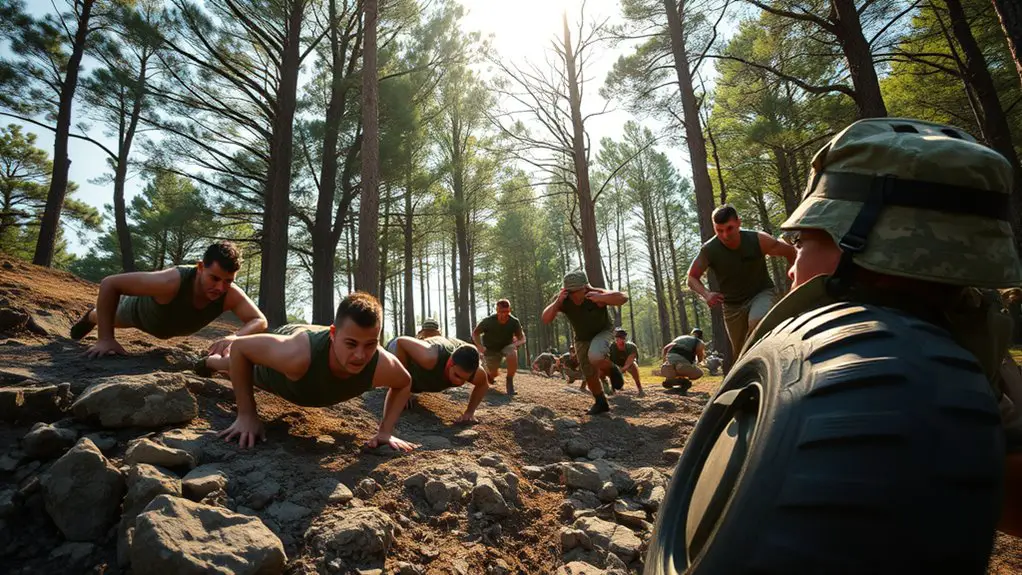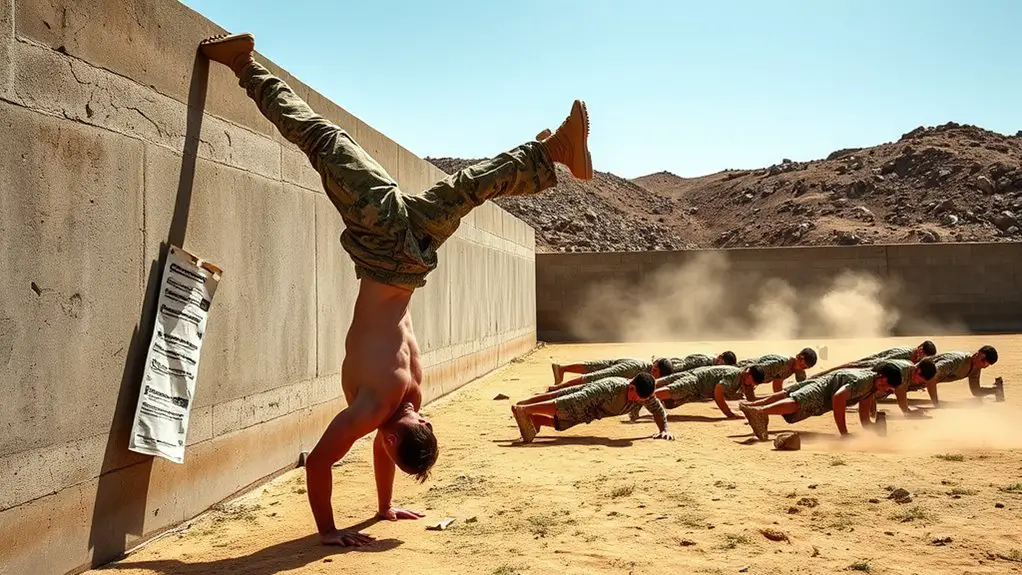How Military Personnel Train for Strength & Endurance

Military personnel build strength and endurance through intense training techniques. You’ll engage in high-intensity interval training (HIIT) to boost efficiency and cardiovascular fitness. Functional movements, like compound lifts and bodyweight exercises, help develop explosive power and overall strength. Endurance comes from rucking and tactical training, which enhance resilience. Recovery and nutrition are just as crucial for peak performance. Explore more strategies behind their rigorous training to understand how they achieve peak fitness.
The Importance of Strength and Endurance in Military Training

When it comes to military training, strength and endurance aren’t just beneficial; they’re essential for survival and success in the field. You need to develop both to handle the physical demands of various missions and scenarios. Building muscle strength not only improves your ability to carry equipment but also enhances your overall stability and resilience against injuries.
Endurance training helps you maintain performance over extended periods, ensuring you can keep pace with your team. But remember, pushing your limits requires careful attention to muscle recovery. Proper recovery techniques, like rest and nutrition, help your body adapt to the stresses of training, enabling you to progress safely and effectively.
High-Intensity Interval Training (HIIT)
High-Intensity Interval Training (HIIT) has become a cornerstone of military fitness programs because it maximizes efficiency in building strength and endurance. One of the key HIIT benefits is its ability to enhance your cardiovascular fitness while minimizing workout time. By incorporating various HIIT techniques, such as sprints followed by active rest, you can challenge your body effectively.
Adaptive HIIT scheduling allows you to tailor workouts based on your fitness level, ensuring you progress safely. It’s essential to include HIIT recovery periods to prevent injury and promote muscle repair. You can also explore different HIIT variations, like cycling or bodyweight exercises, to keep your routine engaging.
Functional Movements and Their Role

Building on the efficiency of HIIT, incorporating functional movements into your training can greatly enhance your overall performance. Functional fitness focuses on exercises that mimic everyday activities, helping you build strength and endurance safely. By emphasizing natural movement patterns, you can improve your coordination, balance, and flexibility, reducing the risk of injury during other activities.
When practicing functional movements, think about how they translate to real-world tasks, like lifting heavy objects or climbing stairs. Exercises like squats, lunges, and push-ups not only strengthen your body but also train it to perform essential tasks more effectively. By integrating these movements into your routine, you’ll develop a more resilient physique, ready for any challenge. Additionally, incorporating pistol squat variations can further enhance your lower body strength and stability.
Remember to prioritize proper form and listen to your body. Gradually increase your intensity, ensuring a safe and effective approach to functional fitness that supports your strength and endurance goals.
Weightlifting Techniques Used by the Military
When it comes to military training, compound lifts play an essential role in building overall strength. You’ll find that Olympic weightlifting methods are often incorporated to enhance power and explosiveness, which are key in combat scenarios. Additionally, functional strength training guarantees that you can apply your strength effectively in real-world situations.
Compound Lifts Importance
While many fitness programs focus on isolation exercises, the military prioritizes compound lifts for their efficiency and effectiveness in building strength and endurance. These lifts, such as squats and deadlifts, engage multiple muscle groups simultaneously, promoting balanced muscle development. By incorporating compound lifts into your routine, you’ll not only increase muscle engagement but also improve functional strength necessary for various physical tasks.
Safety is key when performing these exercises, so always prioritize proper form and technique to avoid injury. Start with lighter weights to master your form before progressing. Remember, compound lifts can be highly beneficial for enhancing overall fitness, making them an essential component of military training that you can also incorporate into your own regimen.
Olympic Weightlifting Methods
In addition to compound lifts, Olympic weightlifting methods play a significant role in military training. These techniques, including Olympic lifts like the clean and jerk or snatch, develop explosive power and enhance overall strength. You’ll find that training variations, such as performing lighter lifts or using resistance bands, can help refine your technique while minimizing injury risks. Focusing on proper form is key—always prioritize safety over lifting heavy weights. By incorporating these Olympic lifts and variations, you’ll not only boost your strength but also improve your coordination and agility. Remember to warm up properly and consider working with a qualified coach to guarantee you’re executing each lift correctly. This way, you’ll maximize your performance while keeping safety at the forefront.
Functional Strength Training
Functional strength training is essential for military personnel, as it emphasizes movements that closely mimic real-life tasks and combat scenarios. By focusing on functional fitness, you’ll build strength that’s applicable to everyday activities, enhancing your overall performance. Exercises like squats, deadlifts, and kettlebell swings improve core stability and power while promoting agility training, which sharpens your reflexes and coordination.
Incorporating balance and flexibility into your routine reduces the risk of injury, ensuring you stay safe while training hard. As you progress, you’ll find that functional strength training not only boosts your physical capabilities but also prepares you mentally for the challenges ahead. Remember, training smart is just as important as training hard, so prioritize safety in every session.
Endurance Running and Rucking
When it comes to endurance running and rucking, mastering the right techniques can make a big difference in your performance. You’ll want to focus on effective strategies that enhance your stamina and strength. Let’s explore some essential tips for both activities.
Rucking Techniques and Tips
Rucking, which combines walking or marching with a weighted pack, is an effective way to build endurance and strength simultaneously. To maximize your rucking experience while ensuring safety, keep these tips in mind:
- Posture: Maintain an upright position with your shoulders back and core engaged to prevent injury.
- Pace: Start slow and gradually increase your rucking pace to build endurance without overexerting yourself.
- Gear: Invest in quality rucking gear, including a comfortable pack and supportive footwear, to enhance performance.
Don’t forget about rucking hydration; drink water before, during, and after your ruck. Also, consider varying your rucking terrain to challenge your muscles. By following these guidelines, you’ll enjoy the many rucking benefits while prioritizing safety.
Endurance Running Strategies
To improve your endurance running, it’s essential to incorporate strategies that complement your rucking regimen. Focus on interval pacing to build speed and stamina safely, allowing for recovery between bursts of effort. Additionally, terrain adaptation is important; vary your running surfaces to strengthen different muscle groups and reduce injury risk.
| Strategy | Purpose | Tips |
|---|---|---|
| Interval Pacing | Boosts speed and endurance | Start with shorter intervals |
| Terrain Adaptation | Enhances muscle strength | Mix flat, hilly, and uneven terrain |
| Hydration Management | Prevents fatigue | Drink water before and after |
| Consistent Warm-ups | Reduces injury risk | Always warm up for 10-15 minutes |
Incorporating these strategies into your routine will help optimize your endurance running performance.
Bodyweight Exercises for Building Strength

Bodyweight exercises are a powerful tool for building strength without the need for gym equipment. They offer numerous calisthenics benefits, such as improved functional strength, better balance, and increased endurance. Plus, you can easily modify bodyweight variations to suit your fitness level, making them safe for everyone.
Here are three effective bodyweight exercises to get you started:
- Push-ups: Great for building upper body strength. Modify them by doing knee push-ups if needed.
- Squats: These strengthen your legs and core. Try single-leg squats for added challenge.
- Planks: Excellent for core stability. You can vary the duration or try side planks to engage different muscles.
Incorporating these exercises into your routine can help you build strength safely and effectively, preparing you for various physical challenges. Remember to maintain proper form to avoid injury!
Tactical Training and Its Physical Demands
While tactical training can be demanding, it’s essential for developing the physical and mental resilience needed in high-pressure situations. You’ll engage in various tactical drills that push your limits, ensuring you’re prepared for any challenge. This training isn’t just about strength; it’s also about enhancing your endurance and agility through rigorous physical conditioning.
Here’s a glimpse at the physical demands you can expect:
| Aspect | Description |
|---|---|
| Endurance Training | Long runs and strenuous hikes |
| Strength Drills | Weight lifting and bodyweight exercises |
| Agility Exercises | Quick directional changes and sprints |
| Coordination Tasks | Complex movements under stress |
| Recovery Techniques | Stretching and proper hydration practices |
Recovery Strategies for Optimal Performance
Recovery is just as important as training when it comes to optimizing your performance. To keep your body functioning at its best, focus on these key recovery strategies:
- Active Recovery: Engage in low-intensity activities like walking or cycling. This helps maintain blood flow and aids in muscle repair.
- Sleep Importance: Prioritize getting enough quality sleep. It’s essential for muscle recovery, cognitive function, and overall well-being.
- Hydration Strategies: Stay hydrated to support muscle function and recovery. Water aids in nutrient transport and helps prevent injuries.
Incorporating practices like massage therapy and foam rolling can relieve muscle tension, while mobility exercises enhance flexibility. Don’t overlook stress management techniques, as they play a significant role in injury prevention and overall performance. Additionally, it’s crucial to listen to your body and consult a doctor if you experience lower back pain, as this can lead to further complications. By integrating these recovery strategies into your routine, you’ll guarantee that your body is ready for the next challenge.
Nutrition for Strength and Endurance
To fuel your training for strength and endurance, it’s essential to pay attention to your nutrition. Balancing macronutrients—proteins, carbohydrates, and fats—ensures you have the energy and muscle recovery needed for intense workouts. Nutritional timing is vital; consuming a mix of protein and carbs before and after training can maximize your performance and recovery. Aim to eat a balanced meal about 2-3 hours before your workout, and don’t forget that post-workout nutrition is just as important to replenish your body’s energy stores.
Hydration strategies also play a key role. Staying hydrated helps maintain your performance and prevents fatigue. Drink water throughout the day, and consider electrolyte-rich beverages if you’re training for extended periods. Listen to your body—if you’re feeling thirsty, it’s a sign you need to hydrate. By focusing on these nutritional elements, you’ll support your strength and endurance goals safely and effectively.
Mental Toughness and Its Impact on Training
Mental toughness is a critical component of successful training, influencing not just physical performance but also your ability to persevere through challenges. Cultivating this resilience can enhance your overall training experience. Here are three focus techniques to help you develop a stronger mindset:
Mental toughness is essential for training success, enhancing both physical performance and your ability to overcome challenges.
- Visualization: Picture yourself overcoming obstacles and achieving your goals. This mental rehearsal boosts confidence and prepares you for real-life scenarios.
- Positive Self-Talk: Replace negative thoughts with affirmations. Encouraging yourself boosts your resilience and keeps you motivated during tough workouts.
- Goal Setting: Break down larger objectives into smaller, achievable tasks. Celebrating these small wins builds confidence and reinforces your commitment.
Frequently Asked Questions
What Equipment Is Commonly Used in Military Strength Training?
When you think about strength training in the military, kettlebell exercises and bodyweight training are often at the forefront. These tools help build overall strength while minimizing injury risk. Kettlebells offer versatility, allowing you to perform various movements that enhance power and endurance. Meanwhile, bodyweight training uses your own weight for resistance, promoting functional strength. Remember, proper form is essential for safety, so always focus on technique to prevent injuries during your workouts.
How Do Military Personnel Avoid Injuries During Training?
To avoid injuries during training, you need to focus on injury prevention strategies. This includes proper warm-ups, using correct techniques, and gradually increasing intensity. You should also incorporate recovery techniques, like stretching and foam rolling, to help your muscles recover. Staying hydrated and getting enough rest is essential too. By listening to your body and taking proactive steps, you can greatly reduce the risk of injury while training effectively.
What Role Does Sleep Play in Military Training Effectiveness?
Did you know that sleep deprivation can reduce your performance by up to 30%? In military training, getting enough sleep is essential for effectiveness. It aids in recovery techniques, helping you bounce back from intense exercises. When you’re well-rested, your body can repair itself, enhancing strength and endurance. Prioritizing sleep not only improves your training but also keeps you safer and more alert, reducing the risk of injuries during demanding tasks.
Are There Specific Training Programs for Different Military Branches?
Yes, there are branch-specific programs tailored for different military branches. Each branch has unique training variations that focus on the skills and physical demands required for its missions. For instance, the Navy emphasizes swimming and water survival, while the Army might focus on land navigation and endurance running. These specialized programs guarantee safety and effectiveness, preparing you for the challenges ahead while addressing the specific needs of your chosen branch.
How Is Progress Measured in Military Strength and Endurance Training?
Progress in military strength and endurance training is measured through various performance metrics, like lifting weight, running times, and endurance tests. You’ll find that progress tracking is essential for ensuring safety and effectiveness. Regular assessments help identify improvements and areas needing attention, allowing you to adjust your training regimen accordingly. By focusing on these metrics, you can work towards your goals while minimizing the risk of injury and ensuring peak performance.





